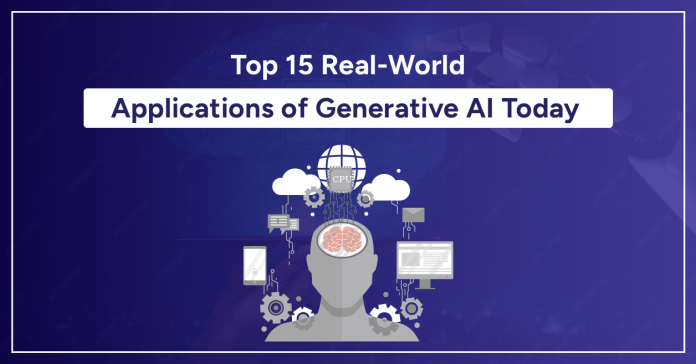Gartner says that by 2026, over 100 million people will use it for their work. McKinsey found that generative AI could add $2.6 trillion to $4.4 trillion to the global economy if used widely. Generative AI is revolutionizing industries by enabling machines to create content—text, images, code, and more—based on learned patterns. From personalized marketing to drug discovery, the real-world applications of Generative AI are expanding rapidly, offering innovative solutions and enhanced efficiency across domains. In this blog, explore 15 impactful ways Generative AI is being used today to solve real-world problems and reshape workflows.
Introduction to Generative AI
Generative AI (Gen AI) is a type of artificial intelligence that learns from examples to create new things. These models are trained on large amounts of data and can make text, images, videos, and more.
Here’s how it works: You give the AI a prompt or idea, and it creates something based on that. For example, if you ask it to write a story about a dragon, it will do that. Similarly, if you ask for a picture of a man in a car, it will create that picture.
In short, generative AI learns from the data it sees and then creates new things. For example, if it has seen many pictures of cats, it can create new cat images that look the same.
Generative AI Applications Examples
You might have heard of AI tools like Google’s Bard, ChatGPT, or DALL-E from OpenAI.
- ChatGPT and DALL-E: These are made by OpenAI, a company supported by Microsoft. In addition, ChatGPT is for chatting, and DALL-E turns text into images.
- Google Bard: Bard is Google’s AI. It works with tools like Google Lens and Gmail. It uses a powerful language model called PaLM-2, trained on a large dataset.
Want to learn how to use these tools and techniques effectively? A Generative AI course offers hands-on experience, covering practical use cases and the latest developments in this cutting-edge field.
15 Real-World Applications of Generative AI
Generative AI (Gen AI) is changing many industries like healthcare, finance, entertainment, and more. Here’s how companies are using it to help customers and improve their services:
1. Best Buy
Best Buy is one of the Genai applications that aid in launching a virtual assistant this summer with Gemini. It will help customers with product issues, delivery schedules, and managing subscriptions. Also, customer service agents will have AI tools to assist customers better.
2. BrainLogic
BrainLogic uses Anthropic’s Claude models on Vertex AI for Zapia, a personal assistant for Latin America. Zapia helps users find products, and businesses, and make purchases. It has received over 90% positive feedback.
3. Cainz
Cainz, a Japanese home improvement store, is building a new store combining online and offline shopping using AI. As a result, this gives customers a faster, smoother shopping experience.
4. Carrefour Taiwan
Carrefour Taiwan added an AI Sommelier to its app. It is one of the generative AI business applications that helps customers choose wines based on their tastes. In addition, it uses a large wine database for better suggestions.
5. Dunelm
Dunelm worked with Google Cloud to improve online shopping. With AI, customers can find products quickly, making the shopping process easier.
6. Eezee
Eezee is one of the best and most common applications of generative AI that uses Gemini models to build a platform connecting small businesses with suppliers in Southeast Asia. As a result, this helps millions of users in the region.
7. Etsy
Etsy uses Vertex AI to improve product search and ads. As a result, buyers get better recommendations, and sellers can grow their businesses.
8. GroupBy
GroupBy created an AI-powered Search and Discovery platform using Vertex AI. This helps online retailers increase sales and build customer loyalty.
9. Magalu
Magalu, Brazil’s top retailer, focuses on customer service with AI. They made “Lu’s Brain,” a 3D bot that helps millions of customers on social media.
10. Mercado Libre
Mercado Libre is one of the generative AI business applications that improve product recommendations with semantic search and Vertex AI. Moreover, this helps over 200 million users find what they need.
11. Target
Target uses Google Cloud for personalized offers and services on its app and website. For example, customers can get special Target Circle offers and use curbside pickup like Starbucks at Drive Up.
12. Tokopedia
Tokopedia, an Indonesian e-commerce company, uses Vertex AI to improve product data. Moreover, this increased the number of unique products sold by 5%.
13. Wendy’s FreshA
Wendy’s FreshAI uses Gemini’s AI with visuals and audio to give customers a more personal experience. As a result, workers can focus on service and meal prep, improving customer experience.
14. Continental
Continental is using Google’s AI technologies to improve car safety. Moreover, they added Google Cloud’s AI to their Smart Cockpit, allowing drivers to use voice commands.
15. General Motors
General Motors improved OnStar with a virtual assistant powered by Google Cloud’s AI. As a result, this helps the system understand and respond to the speaker more easily.
These applications demonstrate the transformative potential of generative AI across multiple sectors, driving innovation and efficiency.
Wrapping Up Thoughts!
In the end, applications of generative AI help businesses grow and stay ahead. It’s also revolutionizing gaming, autonomous vehicles, virtual try-ons, and education by enabling creative content generation and intelligent automation. Generative AI makes it easier for businesses to connect with customers and offer more personal experiences. For example, companies like Best Buy, Carrefour, and Wendy’s use it to improve service and simplify tasks. Retail, automotive, and finance industries use AI to work more efficiently and make better decisions. As technology improves, how companies operate and interact with customers will keep changing.






